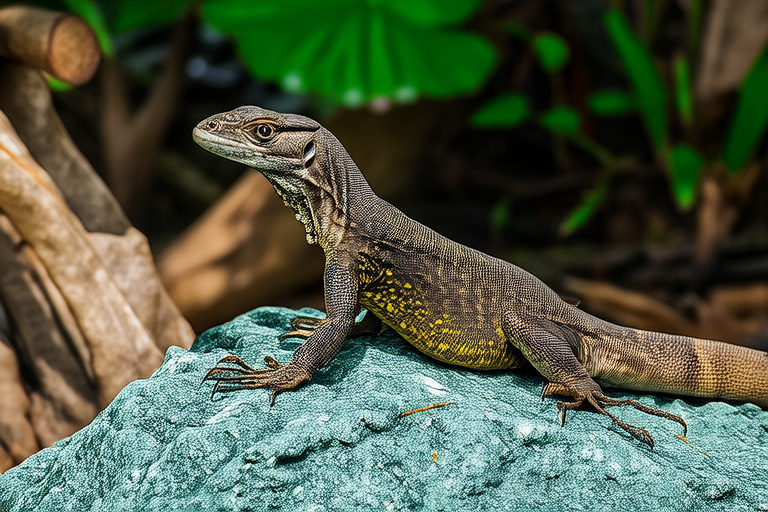The Ultimate Guide to Caring for Your Water Monitor: Tips and Tricks Every Owner Needs
Owning a water monitor is an exciting and rewarding experience, but it comes with significant responsibilities. These intelligent, semi-aquatic reptiles require specialized care to thrive in captivity. Whether you’re a new or experienced owner, this comprehensive guide will walk you through everything you need to know about habitat setup, diet, handling, health monitoring, and general care practices to ensure your water monitor lives a happy and healthy life.
Habitat Setup: Creating the Perfect Environment
A proper habitat is crucial for your water monitor’s physical and mental well-being. Here’s how to set up an ideal environment:
Tank Size
Water monitors are large, active reptiles that need ample space to move around. For juveniles, a tank size of at least 6 feet long, 3 feet wide, and 3 feet high is recommended. Adult water monitors require even larger enclosures, typically measuring 8-12 feet in length. Custom-built enclosures are often necessary to accommodate their size.
Temperature
Maintaining the correct temperature gradient is essential. The warm side of the enclosure should be kept between 90°F and 95°F (32°C-35°C), while the cooler side should range from 75°F to 80°F (24°C-27°C). Use heat lamps or ceramic heat emitters to achieve these temperatures, and always use a reliable thermometer to monitor them.
Humidity
Water monitors thrive in environments with high humidity levels, ideally between 70% and 80%. Mist the enclosure daily using a spray bottle or install an automatic misting system. A large water dish or shallow pool within the enclosure can also help maintain humidity and provide opportunities for soaking.
Lighting
UVB lighting is critical for your water monitor’s health, as it aids in calcium absorption and prevents metabolic bone disease. Use a high-quality UVB bulb designed for reptiles and replace it every 6-12 months, as the effectiveness diminishes over time. Provide a photoperiod of 10-12 hours of light per day to mimic natural daylight cycles.
Diet and Nutrition: Feeding Your Water Monitor
A balanced and varied diet is key to keeping your water monitor healthy and energetic.
Food Variety
Water monitors are carnivorous and opportunistic feeders in the wild. In captivity, they can eat a variety of foods, including insects (like crickets and roaches), rodents (such as mice and rats), fish, eggs, and occasionally cooked lean meats like chicken. Avoid feeding them raw pork or beef due to the risk of parasites.
Feeding Frequency
Juvenile water monitors should be fed daily, while adults can be fed every 2-3 days. Adjust portion sizes based on your monitor’s appetite and body condition. Overfeeding can lead to obesity, so monitor their weight regularly.
Calcium and Vitamin Supplements
To prevent nutritional deficiencies, dust feeder insects and other food items with calcium powder twice a week and a multivitamin supplement once a week. This ensures your water monitor receives all the essential nutrients it needs.
Handling and Socialization Tips
Building trust with your water monitor takes time and patience. Follow these tips to make handling a positive experience for both you and your pet:
Start Slowly
Begin by allowing your water monitor to get used to your presence. Spend time near its enclosure without making sudden movements. Gradually introduce your hand into the tank, letting the monitor sniff and explore at its own pace.
Use Proper Handling Techniques
Always support your water monitor’s entire body when picking it up. Avoid grabbing it by the tail, as this can cause injury. Approach calmly and confidently, and never attempt to handle a stressed or defensive monitor.
Socialization Benefits
Regular interaction helps build trust and reduces stress. However, avoid excessive handling, as water monitors are not naturally social animals and may become overwhelmed. Aim for short, positive sessions several times a week.
Health Monitoring: Keeping an Eye on Your Monitor’s Well-Being
Early detection of potential health issues is vital for ensuring your water monitor stays in top condition.
Common Illnesses
Some common ailments include respiratory infections, parasitic infestations, and metabolic bone disease. Symptoms such as wheezing, nasal discharge, lethargy, or swollen limbs warrant immediate veterinary attention.
Signs of Distress
Watch for changes in behavior, appetite, or appearance. Refusal to eat, excessive hiding, or abnormal feces could indicate underlying problems. Regularly check for signs of mites, injuries, or shedding difficulties.
Veterinary Care
Find a qualified reptile veterinarian before bringing your water monitor home. Schedule annual check-ups and seek professional advice whenever you notice something unusual. Keep records of your monitor’s growth, diet, and any medical treatments.
General Care Practices: Maintaining a Happy Home
Beyond the basics, there are additional steps you can take to enhance your water monitor’s quality of life.
Cleaning the Enclosure
Spot-clean the enclosure daily by removing waste and uneaten food. Perform a thorough cleaning of the entire habitat every 1-2 weeks, disinfecting surfaces with reptile-safe cleaners. Always rinse thoroughly to remove any chemical residue.
Enrichment Activities
Provide branches, rocks, and hides to create a stimulating environment. Rotate enrichment items periodically to keep your monitor engaged. You can also offer puzzle feeders or scatter food around the enclosure to encourage natural foraging behaviors.
Monitoring Growth
Track your water monitor’s growth by weighing it monthly and recording measurements. Sudden weight loss or stunted growth may signal dietary or health issues that need addressing.
Conclusion: Committing to Excellence in Care
Caring for a water monitor is a long-term commitment that requires dedication, knowledge, and resources. By providing a suitable habitat, a nutritious diet, regular handling, vigilant health monitoring, and consistent care practices, you can ensure your water monitor thrives under your care. Remember, a happy and healthy water monitor is a testament to your hard work and love as a responsible reptile owner.
If you’re considering adding a water monitor to your family, take the time to educate yourself fully and prepare accordingly. With the right approach, these fascinating creatures can bring years of joy and companionship into your life.
